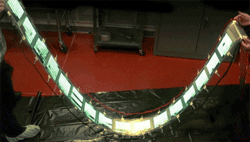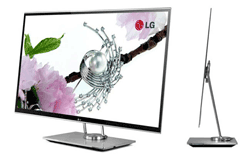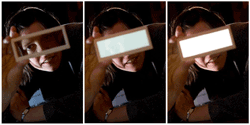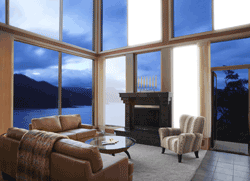Low-cost manufacturing processes, enhanced materials, and unique design features could reinvent how we use light and view displays
BY MICHAEL J. KAWA
Organic light-emitting diodes (OLEDs) are solid-state devices that emit light when an electrical charge is applied to layers of organic material. The material is applied to a supportive substrate made of metal, glass, or plastic. By using different layer structures in OLED architectures and drive methods to control their pixel matrices, manufacturers can create energy-efficient visual displays or lighting panels.
OLED pixel layers are currently applied to the substrate by evaporation techniques that are very expensive and time consuming. While the manufacturing methods produce high-performance product, they are only suitable for small panel sizes and lower-volume production.
Attempts to scale to larger sizes using alternative methods have often resulted in loss of display performance and life. However, new manufacturing methods, combining features of the evaporation technique with ink-jet printing are making it possible to produce superior OLED pixels over a large surface area. The new process turns OLED molecules into ink, which is then printed and processed on the substrate one layer at a time to ensure proper pixel formation.
This could lead to low-cost, high-volume printing using flexible substrates. Large sheets of OLED thin films could be printed en mass on roll to roll production lines much like old newspapers. In May 2010, DuPont and Dainippon Screen successfully displayed their own high-speed multinozzle process by printing out a working 50-in. OLED TV display in less than two minutes!

GE demonstrates its own roll-to-roll OLED display manufacturing.
As manufacturing methods continue to mature, OLED technology will enter into widespread commercialization. When it emerges, the display and lighting markets will never be the same.
OLED displays
OLEDs provide high-quality flat-surface displays that produce stunning high-resolution images filled with rich detail, enormous color depth and a bright eye catching intensity which can be viewed from any angle.
They are energy efficient, lightweight and have a thin design structure which can be produced on rigid or flexible substrates. By using Active-Matrix OLED (AMOLED) drive architectures, TFT backplanes can be embedded into the substrate allowing pixel data to be directly driven and buffered at each pixel location. This creates rapid response times of less than 1 μs, enabling displays to have seamless blur free motion.

Scaling up in size: LG will be offering a new 31-in. OLED 3D TV which is only 0.11 in. (2.9-mm) thick. The screen size is double that of current available models.
A key feature of OLED displays is that they do not require backlighting like LCDs. OLEDs emit their own light, which enables them to produce larger fields of view and emit greater display intensities because their source light is unobstructed.
Their pixels also produce a true black color in the off-state. This allows their screens to mix deeper blacks against stronger vibrant colors to create an almost infinite contrast ratio. Since no power is used by pixels in the off-state and there is no backlight to power, OLED displays consume much less power than other display technologies, an important consideration for battery-operated devices.
Display life has been substantially improved through innovative designs and enhanced materials, which address the life limitations of the blue emitter. One leading-edge architecture developed by Universal Display adds a light blue subpixel to the standard three-color RGB matrix. This pixel is made of longer-lived materials that satisfy most of the blue emission requirements and reduces the workload on the deep blue pixel, increasing its life and the overall life of the display.
OLED displays are currently used in a variety of small-screen applications that require high picture quality and energy-efficient design. They are ideal solutions for mobile electronic devices such as smart phones, touchscreen tablets, and digital cameras. As they scale to larger sizes, they are being used as digital signs, computer monitors, and TV screens. When configured as a lighting panel, OLEDs also make excellent energy-efficient backlights for these devices.
As OLED displays become more available, expect designers to incorporate their unique features in a variety of new applications that could become the new norm: cardboard-thin, large-screen smart TVs that could be rolled up and stored when not in use, emissive electronic newspapers with wireless auto-feed updates, heads-up displays on car dashboards that provide useful hands-free information, and wearable dynamic interfaces with touchscreen technology enabling smart phones or computers to comfortably wrap around your wrist or forearm.

A prototype flexible e-reader from LG designed to mimic the look and feel of a newspaper page.
OLED lighting panels
OLEDs provide uniform surface area lighting in an ultrathin form factor. Their light is diffuse and available in colors across the visible spectrum. White-light OLEDs have a broad emission spectra with warm color temperatures and high color rendering, which results in a comfortable glare-free natural light.
These lightweight lighting tiles are inherently flat and can be made flexible or rigid. In the off-state, they can be transparent, diffuse, or reflective, depending on the device architecture and materials used in the substrate.

A white OLED lighting panel from Philips is transparent when turned off.
The lighting panels have a large active area that can be top or bottom emissive, or can emit light from both sides when transparent. They are fully dimmable, can be switched on or off with no time delay, emit no noise, and have a wide operating temperature range.
Commercially available white OLED panels currently provide lighting efficacies of 30 to 50 lm/W, luminous intensities of 1,000 cd/m2 and lifetimes of 10,000 hours. They have low power-consumption levels and are environmentally safe, making them very eco-friendly.
Panel designs can be configured into a variety of shapes and sizes to accommodate a wide range of applications. New manufacturing methods are allowing the technology to be scaled to larger sizes without losses in efficiency or light uniformity. Larger-panel applications are currently made by integrating multiple smaller OLED tiles into a single luminaire.
A unique feature of OLED technology is that it can be directly embedded in nonlighting materials such as metal, glass, or fabrics. This essentially gives lighting designers a new building block where any object or room structure from floor to ceiling can be turned into a light source.
OLED embedded windows could emit light during the evening and return to normal transparency during the day. Embedded wallpaper could be configured in each room to produce different lighting patterns, colors, or graphics to create mood or fulfill need. OLED smart lighting could illuminate floor segments as you approach and dim as you walk away. The possibilities are endless.

OLEDs offer exciting new ways of applying light. (Press picture: OSRAM, Siemens.)
In the future, lighting will no longer be limited by conventional designs determined by nonuniform single-point or linear light sources. OLEDs will provide a completely new platform for lighting design where the only limitation will be the imagination. ■
Advertisement
Learn more about Electronic Products Magazine





